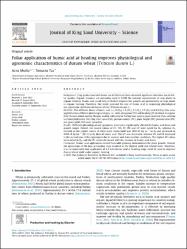| dc.contributor.author | Mutlu, Arzu | |
| dc.contributor.author | Taş, Timuçin | |
| dc.date.accessioned | 2023-08-08T12:46:17Z | |
| dc.date.available | 2023-08-08T12:46:17Z | |
| dc.date.issued | 2022 | en_US |
| dc.identifier.issn | 1018-3647 / 2213-686X | |
| dc.identifier.uri | https://doi.org/10.1016/j.jksus.2022.102320 | |
| dc.identifier.uri | https://hdl.handle.net/20.500.12462/13262 | |
| dc.description | Taş, Timuçin (Balikesir Author) | en_US |
| dc.description.abstract | Background: Crop production with lesser use of chemicals have attracted significant attention due to better quality. Organic manures are commonly used to fulfill the nutrient requirements of crop plants in
organic farming. Humic acid could help to further improve the growth and productivity of crop plants
in organic farming. Therefore, this study assessed the role of humic acid in improving physiological
and agronomic attributes of durum wheat (Triticum durum L.).
Methods: Five different doses of humic acid, i.e., 0 (H0), 1.5 (H1), 2.5 (H2), 3.5 (H3) and 4.5 (H4) L/ha were
applied at two different phenological stages, i.e., stem elongation (SE) and heading (H) of wheat in organic
field. Durum wheat variety ‘Burgos’ widely cultivated in Turkey was used as plant material. Data relating
to chlorophyll index (CC), flag sheet area (FSA), proline content (PC), plant height (PH), protein ratio (PR),
and grain yield (GY) were recorded.
Results: Different physiological and agronomic traits were significantly affected by humic acid doses and
growth stages. Overall, the lowest values of CC, FSA, PC, PH and GY were noted for H0, whereas H4
resulted in the highest values of these traits. Grain yield was 3882.82 kg ha 1 in H0 and increased to
4988.14 kg ha 1 (28 %) in H4 dose of humic acid. The GY was decreased, whereas PC and PR increased
in the second year of the experiment due to warmer and drier weather conditions. The highest PC values
were noted in H0, and the PC values decreased with the increase in humic acid doses.
Conclusion: Humic acid application created favorable growing environments for plant growth. Overall,
the application of H4 dose at heading stage resulted in the highest yield and related traits. Therefore,
it is recommended that application of 4.5 L/ha humic acid at heading stage could be used to improve
durum wheat yield under organic farming. | en_US |
| dc.language.iso | eng | en_US |
| dc.publisher | Elsevier | en_US |
| dc.relation.isversionof | 10.1016/j.jksus.2022.102320 | en_US |
| dc.rights | info:eu-repo/semantics/openAccess | en_US |
| dc.rights | Attribution-NonCommercial-NoDerivs 3.0 United States | * |
| dc.rights.uri | http://creativecommons.org/licenses/by-nc-nd/3.0/us/ | * |
| dc.subject | Humic Acid | en_US |
| dc.subject | Grain Yield | en_US |
| dc.subject | Proline Content | en_US |
| dc.subject | Chlorophyll Index | en_US |
| dc.subject | Regression Analysis | en_US |
| dc.title | Foliar application of humic acid at heading improves physiological and agronomic characteristics of durum wheat (Triticum durum L.) | en_US |
| dc.type | article | en_US |
| dc.relation.journal | Journal of King Saud University - Science | en_US |
| dc.contributor.department | Kepsut Meslek Yüksekokulu | en_US |
| dc.contributor.authorID | 0000-0002-2144-9064 | en_US |
| dc.identifier.volume | 34 | en_US |
| dc.identifier.issue | 8 | en_US |
| dc.identifier.startpage | 1 | en_US |
| dc.identifier.endpage | 10 | en_US |
| dc.relation.publicationcategory | Makale - Uluslararası Hakemli Dergi - Kurum Öğretim Elemanı | en_US |




















